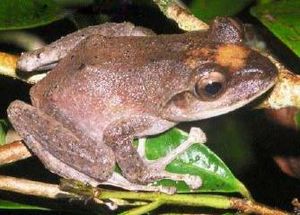Platymantis facts for kids
Quick facts for kids Platymantis |
|
|---|---|
 |
|
| Fiji tree frog (Platymantis vitiensis) | |
| Scientific classification | |
| Type species | |
| Halophila vitiensis Girard, 1853
|
Platymantis is a group of frogs that belong to the family Ceratobatrachidae. These frogs are often called by several common names, like wrinkled ground frogs, ground frogs, or forest frogs. They get these names because many of them live on the ground in forests.
Contents
About Platymantis Frogs
Platymantis is a large group, or genus, of frogs. Scientists have found about 60 different kinds, or species, of Platymantis frogs. Most of these species live in the Philippines, a country made of many islands in Southeast Asia. Some species are also found in other parts of Oceania, like Fiji.
These frogs are special because they do not need water to lay their eggs. Instead, they lay their eggs on land, often under leaves or in damp places. The eggs hatch directly into tiny froglets, skipping the tadpole stage that most frogs have. This is called "direct development."
What Makes Them Special
Platymantis frogs are known for their unique way of growing up. Unlike many other frogs, their babies do not start as tadpoles swimming in water. Instead, the eggs hatch directly into small frogs that look like miniature versions of their parents. This helps them live in places where there might not be much standing water.
Scientists are still learning about all the different types of Platymantis frogs. They are studying how these frogs are related to each other and to other frog groups. This helps them understand the amazing variety of life on Earth.
Where Platymantis Frogs Live
Most Platymantis frogs live in the Philippines. This country has many islands with different kinds of forests, from lowlands to mountains. These forests provide the perfect damp and leafy homes for these ground-dwelling frogs.
Some species of Platymantis are also found on islands in Oceania, such as Fiji. They prefer moist environments, often hiding among leaf litter or under rocks. Their camouflage helps them blend in with their surroundings, protecting them from predators.
Images for kids
See also
 In Spanish: Platymantis para niños
In Spanish: Platymantis para niños


